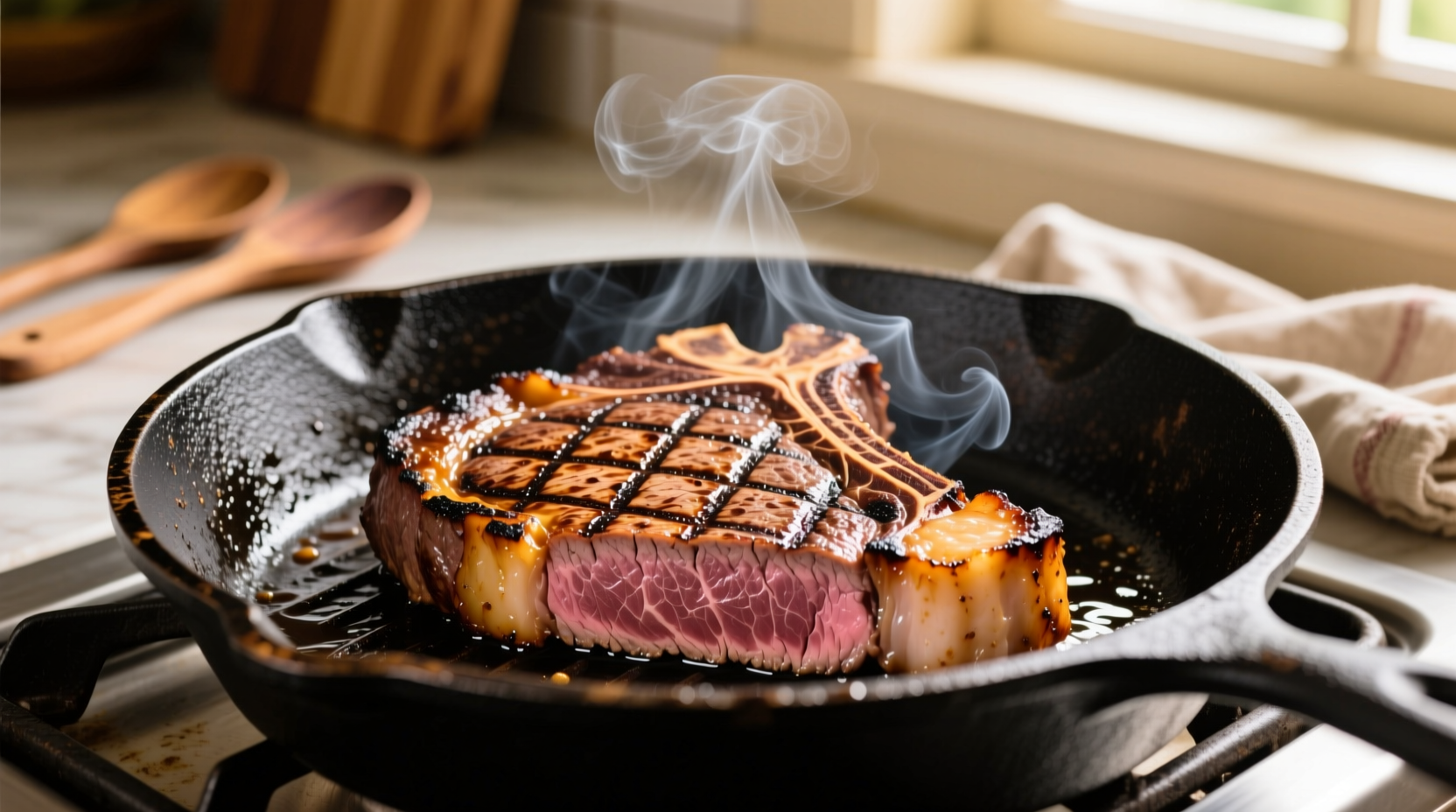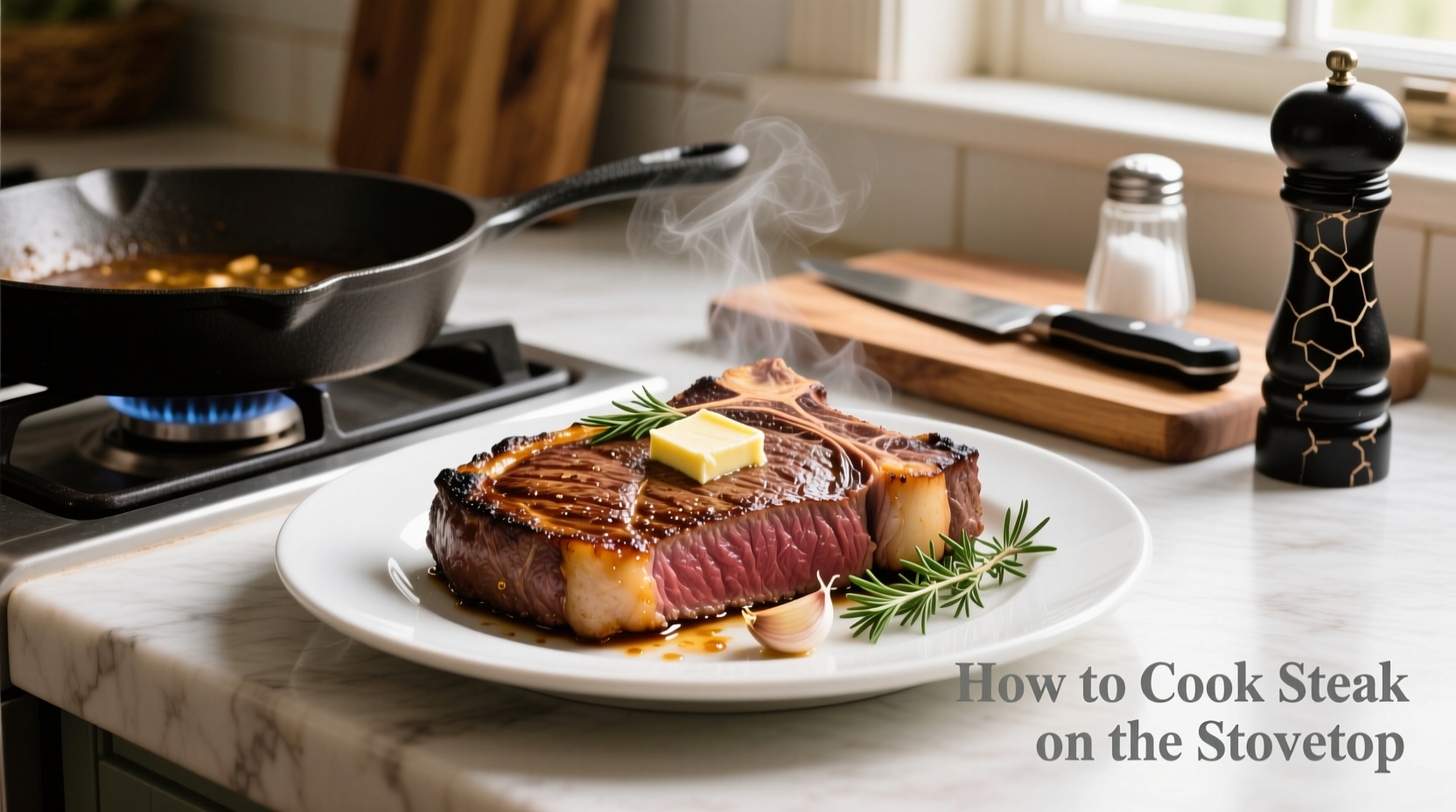For perfect stovetop steak, select a 1-1.5 inch thick cut like ribeye or strip steak, bring to room temperature, season generously with salt and pepper, sear in a smoking hot cast-iron skillet for 3-4 minutes per side, then finish to desired doneness (125°F for rare, 135°F for medium-rare), and rest for 5-10 minutes before serving. This method delivers restaurant-quality results with a perfect crust and juicy interior.
Why Stovetop Steak Cooking Beats Other Methods
When you're craving a perfectly cooked steak but don't want to fire up the grill or heat the entire house with your oven, your stovetop becomes your secret weapon. Unlike broiling which can create uneven cooking, or sous vide which requires special equipment, stovetop cooking gives you immediate control over the sear and doneness. Professional chefs rely on this method because it creates that coveted Maillard reaction—the chemical process that develops complex flavors and that beautiful brown crust—while maintaining precise temperature control.
Your Essential Stovetop Steak Toolkit
Before you even think about turning on your burner, gather these critical tools:
- Cast-iron skillet (10-12 inch): Retains heat better than any other pan for consistent searing
- Instant-read thermometer: The only reliable way to check doneness (more on temperatures below)
- Heavy tongs: For flipping without piercing the meat
- Timer: Critical for precision cooking
- Metal spatula: For pressing against the steak during searing
Selecting the Perfect Cut for Stovetop Success
Not all steaks perform equally on the stovetop. Your best options have enough marbling to stay juicy during high-heat cooking:
- Ribeye (1-1.5 inches thick): Rich marbling creates incredible flavor and juiciness
- New York strip (1-1.5 inches): Balanced marbling with firm texture
- Filet mignon (1.5-2 inches): Less marbling but extremely tender (requires careful monitoring)
- Porterhouse/T-bone: Two steaks in one, but challenging to cook evenly on stovetop
Avoid thin cuts under 1 inch—they'll overcook before developing a proper crust. For optimal stovetop results, thickness matters more than premium labeling; a well-chosen choice steak often outperforms a thin prime cut.
Preparation: The Secret Step Most Home Cooks Skip
Proper preparation separates decent steak from extraordinary steak. Follow these steps 45-60 minutes before cooking:
- Remove steak from refrigerator and place on a wire rack over a plate
- Pat thoroughly dry with paper towels (moisture is the enemy of searing)
- Season generously with coarse kosher salt (1 teaspoon per pound) and freshly ground black pepper
- Let sit at room temperature until the surface feels dry to the touch
This critical resting period allows the salt to penetrate while the surface dries—essential for that perfect crust. Never season immediately before cooking; this draws out moisture and prevents proper searing.
Mastering the Stovetop Cooking Process
Follow this precise sequence for flawless results:
Step 1: Heat Your Pan Properly
Place your cast-iron skillet over medium-high heat for 5-7 minutes until smoking hot. Test by sprinkling a few drops of water—if they sizzle and evaporate immediately, you're ready. Add 1-2 tablespoons of high-smoke point oil (avocado, grapeseed, or clarified butter).
Step 2: The Initial Sear
Place steak in the pan away from you to avoid oil splatter. Press gently with a spatula for 15 seconds to ensure full contact. Cook undisturbed for 3-4 minutes until a deep brown crust forms. Flip using tongs—never pierce with a fork.
Step 3: Building Flavor Complexity
After flipping, add aromatics to the hot oil: 2-3 sprigs fresh thyme, 2 crushed garlic cloves, and 2 tablespoons unsalted butter. Tilt the pan and spoon the melted butter continuously over the steak for 60-90 seconds. This basting technique infuses flavor without moving the steak.
Step 4: Checking Temperature
Insert an instant-read thermometer horizontally into the thickest part:
| Doneness | Temperature | Visual Cue |
|---|---|---|
| Rare | 120-125°F (49-52°C) | Very soft, cool red center |
| Medium-rare | 130-135°F (54-57°C) | Soft, warm red center |
| Medium | 140-145°F (60-63°C) | Springy, warm pink center |
| Medium-well | 150-155°F (66-68°C) | Firm, slightly pink center |
| Well-done | 160°F+ (71°C+) | Very firm, no pink |
Remember: USDA food safety guidelines confirm that steak is safe to eat at 145°F with a 3-minute rest time, but most culinary professionals recommend lower temperatures for optimal texture and flavor. The internal temperature will continue rising 5-10 degrees during resting.
When Stovetop Cooking Isn't Ideal: Context Boundaries
While stovetop cooking delivers excellent results for most steaks, recognize these limitations:
- Very thick cuts (over 2 inches): Risk of burnt exterior before interior reaches desired temperature
- Lean cuts like flank or skirt steak: Better suited to high-heat grill for quick cooking
- Multiple steaks: Pan crowding lowers temperature, preventing proper sear
In these cases, consider the reverse sear method (oven finish) or alternative cooking techniques. For standard 1-1.5 inch steaks, however, stovetop remains the gold standard for home cooking.
Resting: The Non-Negotiable Final Step
After removing steak from heat, place it on a cutting board or warm plate and tent loosely with foil. Rest for 5-10 minutes (longer for thicker cuts). This critical step allows:
- Redistribution of juices throughout the meat
- Carryover cooking to reach final target temperature
- Relaxation of muscle fibers for improved tenderness
Cutting too soon releases precious juices onto your plate instead of staying in the steak. Time your side dishes to finish during this resting period.
Troubleshooting Common Stovetop Steak Problems
Problem: Steak sticks to the pan
Solution: The pan wasn't hot enough before adding steak. Wait until it releases naturally before attempting to flip.
Problem: Uneven cooking
Solution: Steak wasn't at room temperature before cooking. Always allow adequate resting time after removing from refrigerator.
Problem: Burnt exterior but raw interior
Solution: Pan temperature too high. Reduce heat slightly after initial sear, or choose a slightly thicker cut.

Perfecting Your Technique Through Practice
Mastering stovetop steak requires understanding your specific stove and equipment. Gas stoves provide more immediate temperature control than electric, but both work well with practice. Track your results: note the exact cut, thickness, starting temperature, pan temperature, cooking times, and final internal temperature. Within 3-4 attempts, you'll develop intuition for your particular cooking environment. Remember that variables like ambient temperature, steak thickness, and even the specific cut can affect cooking time—your thermometer is your most reliable guide.
FAQ: Stovetop Steak Cooking Questions Answered
How long should I cook a 1-inch steak on the stovetop for medium-rare?
Cook a 1-inch steak for 3-4 minutes per side in a smoking hot skillet. Use an instant-read thermometer to confirm 130-135°F internal temperature before resting. Total cooking time including resting should be 12-15 minutes.
Can I cook steak on the stovetop without cast iron?
Yes, but results will vary. Carbon steel works nearly as well as cast iron. Stainless steel can work but requires more precise temperature control. Non-stick pans shouldn't be used for high-heat searing as they can't reach the necessary temperatures and may release harmful fumes.
Why does my steak release so much liquid when I cut it?
This happens when you cut too soon after cooking. Resting for 5-10 minutes allows proteins to reabsorb juices. Cutting immediately releases these juices onto your plate. Always rest your steak before slicing.
Should I oil the steak or the pan when cooking?
Oil the pan, not the steak. Oiling the pan ensures even coverage and prevents the oil from burning off the steak's surface. Use 1-2 tablespoons of high-smoke point oil added to the hot pan just before adding the steak.
How do I prevent excessive smoke when cooking steak indoors?
Use proper ventilation (turn on exhaust fan), choose an oil with high smoke point (avocado or grapeseed oil), and avoid overheating the pan beyond the oil's smoke point. Opening windows and temporarily disabling smoke alarms (safely) can also help during the searing process.











 浙公网安备
33010002000092号
浙公网安备
33010002000092号 浙B2-20120091-4
浙B2-20120091-4